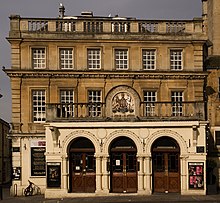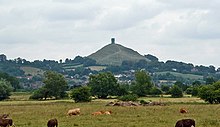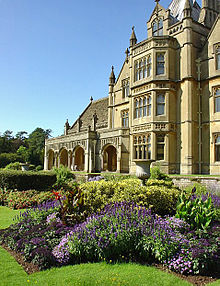Culture of Somerset
Somerset is a county in the south west of England. It has a varied cultural tradition ranging from the Arthurian legends to The Wurzels, a band specialising in Scrumpy and Western music.

Art, music, film and literature
Traditional folk music, both song and dance, was important in Somerset's agrarian communities. Somerset songs were collected by
Wordsworth and Coleridge wrote while staying in Coleridge Cottage, Nether Stowey.[2] The writer Evelyn Waugh spent his last years in the village of Combe Florey.[3] The novelist John Cowper Powys (1872–1963) lived in the Somerset village of Montacute from 1885 until 1894 and his novels Wood and Stone (1915) and A Glastonbury Romance (1932) are set in Somerset. His brothers, T. F. Powys and Llewelyn Powys, were also successful writers.
Many traditional rural trades such as basket making have survived, and many other crafts such as jewelry, leatherwork and pottery can be found at studios around the county.[4]
An annual competition for the
Theatres

In 2004, the Next Stage Theatre Company took possession of a grade II listed building in Bath originally built as a Congregational hall in 1797,[8] which had been used by The People's Mission until 1998, and began building work to convert it into the Mission Theatre. It is now owned by the Bath and North East Somerset Council, which has granted a lease to occupy and use the building as a 100-seat theatre, arts centre and multi-purpose facility for community activities. On the first floor there is a small 30-seat theatre (The Theatre Upstairs) and a Bistro open during the day and providing meals before performances in the theatre. The Rondo Theatre, which was established in 1989, is located in the former church hall of St. Saviours Church, Larkhall. The building, purchased in 1976 by Doreen and Wilf Williams, has been converted into a 105-seat theatre. The facility received extensive renovations and upgrades after the receipt of lottery grants in 1996 and 2003.[9]
The
There are two theatres in
Festivals

The
The annual Bath Literature Festival is one of several local festivals in the county which include the Frome Festival and the Trowbridge Village Pump Festival, which, despite its name, is held at Farleigh Hungerford in Somerset.

The annual circuit of West Country Carnivals is held in a variety of Somerset towns during the autumn, forming a major regional festival, and the largest Festival of Lights in Europe.[20] It is an annual celebration featuring a parade of illuminated floats (termed "carts" locally), in the English West Country. The celebration dates back to the Gunpowder Plot of 1605. The series of parades in each town now form a major regional festival. Some carts cost in excess of £20,000 to build and are the result of thousands of man hours work throughout the year.[21] The event's purpose, as it has always been from the start, is to raise thousands of pounds for local charities from money collection carts in the two-hour procession. In several villages Punkie Night is celebrated each October.[22]
Many villages had
The Weston-super-Mare Sand Sculpture Festival is held annually on the beach at Weston-super-Mare.[24] The Bridgwater Science Festival is held each year in the Town Hall and other venues in Bridgwater.
Legends and religion

According to Arthurian legend, Avalon became associated with Glastonbury Tor when monks at Glastonbury Abbey claimed to have discovered the bones of King Arthur and his queen.[25] What is more certain is that Glastonbury was an important religious centre by 700. It claims to be "the oldest above-ground Christian church in the World"[26] by dating the founding of the community of monks to AD 63, the year of the legendary visit of Joseph of Arimathea, who was supposed to have brought the Holy Grail to England.[26]
During the Middle Ages there were also important religious sites at
Many legends exist about Somerset. The Stanton Drew stone circles are said to have been formed when a wedding party continued to dance on the Lord's day.[28] Likewise the Witch of Wookey Hole is said to have been turned to stone by a priest.
The Norton Fitzwarren Dragon is just one of many stories about dragons in Somerset. After a battle a dragon was formed from the pile of corpses and it began terrorising the area by devouring children and destroying crops. A young man took on the beast and after a long and bloody struggle, he pierced the dragons heart and cut off its head. In All Saints Church, a sixteenth-century rood screen depicts the story.
Museums and art galleries

There are a number of museums and art galleries in the county, several of which are in Bath. These include: the
The main Museum of Somerset along with the Somerset Military Museum are in Taunton Castle, while museums such as the Blake Museum, Weston Museum, the Somerset Rural Life Museum in Glastonbury and the Peat Moors Centre, explore the counties rural history and crafts.
Other visitor attractions reflect the cultural, historical and industrial heritage of the county: Claverton Pumping Station, Dunster Working Watermill, Nunney Castle, King John's Hunting Lodge in Axbridge, Radstock Museum and Westonzoyland Pumping Station Museum.
More recent technology is exhibited at the Fleet Air Arm Museum at Yeovilton, The Helicopter Museum in Weston-super-Mare and Haynes International Motor Museum in Sparkford.
Historic buildings
Somerset has 11,500
Sport

The Somerset County Cricket Club is one of the 18 major county clubs which make up the English domestic cricket structure, representing the historic county of Somerset. Its limited overs team is called the Somerset Sabres. The club has its headquarters at the County Ground, Taunton. First-class games are also played at Bath. Former grounds include Weston-super-Mare, Frome, Glastonbury, Wells and the Imperial Tobacco ground in south Bristol. Amateur cricket is also played by teams in the North Somerset Cricket League and West of England Premier League.
Yeovil Olympiads Athletics Club in Yeovil was founded in 1969 and has produced many international athletes since its creation. The first was Eric Berry who came 6th in the 1973 European Juniors in the hammer event. Olympians who started with the club include Max Robertson and Gary Jennings, both 400 metres hurdlers.
The
There are several golf courses including Enmore Park Golf Club.
Media
In addition to the
(previously known as HTV).See also
References
- ^ "Review: The Wurzels' Big Summer Party". BBC Somerset. Retrieved 21 October 2007.
- ^ Everett, Glenn. "William Wordsworth: Biography". The Victorian Web. Retrieved 7 January 2007.
- ISBN 0-7126-3733-8.
- ^ "Arts & Culture in Somerset". visitsomerset.co.uk. Somerset County Council. Retrieved 10 May 2008.
- ^ "Bard of Bath". Bard of Bath. Retrieved 10 January 2011.
- ISBN 0-7091-9883-3.
- ^ "Garrick's Head Public House & Theatre Royal". Images of England. English Heritage. Archived from the original on 12 October 2012. Retrieved 23 August 2009.
- ^ "People's Mission Hall". Images of England. Archived from the original on 22 October 2012. Retrieved 10 January 2008.
- ^ "General Information". The Rondo Theatre. Retrieved 16 December 2016.
- ^ "Our History". Clarence Park Baptist Church. Archived from the original on 29 September 2007. Retrieved 4 July 2007.
- ^ "Short History". Friends of the Blakehay. Archived from the original on 18 January 2007. Retrieved 4 July 2007.
- ^ "Blakehay keys handed over to town council". The Weston Mercury. 27 September 2004. Archived from the original on 27 September 2007. Retrieved 4 July 2007.
- ^ "Theatre history". The Playhouse, official website. Retrieved 27 August 2006.
- ^ "About us". Brewhouse Theatre. Archived from the original on 6 January 2010. Retrieved 10 January 2010.
- ^ "Strode Theatre". Strode College. Retrieved 4 July 2010.
- ^ "Strode Theatre". Total Travel.com. Archived from the original on 31 January 2010. Retrieved 4 July 2010.
- ^ "Frome Memorial Theatre". Frome Memorial Theatre. Retrieved 29 September 2008.
- ^ "Merlin Theatre". Merlin Theatre. Retrieved 29 September 2008.
- ^ "Extra Glastonbury Tickets Snapped Up". Contact Music. 22 April 2007. Retrieved 22 October 2007.
- ISBN 1-84114-483-5.
- ^ "Failed gunpowder plot sparks carnival history". BBC Somerset. BBC. Retrieved 3 July 2008.
- JSTOR 1259549.
- ^ Fuller, Margaret (1964). West Country Friendly Societies: An Account of Village Benefit Clubs and their Brass Pole Heads. Oakwood Press & University of Reading. p. 119.
- ^ "Weston super Mare sand sculpture festival". Weston super Mare sand sculpture festival. Retrieved 5 May 2014.
- ^ "King Arthur and Glastonbury". Britain Express. Retrieved 23 October 2007.
- ^ a b "Welcome to Glastonbury Abbey's Official Website". Glastonbury Abbey. Retrieved 23 October 2007.
- ^ "Parish Churches". Aspects of Somerset History. Somerset County Council. Archived from the original on 5 October 2013. Retrieved 11 May 2008.
- ^ "The Dancers of Stanton Drew". A Collection of British Legends. Britannia.com, LLC. 2000. Retrieved 11 May 2008.
- ^ Rajan, Amal (24 August 2007). "Around a county in 40 facts: A (very) brief history of Somerset". Independent on Sunday. Archived from the original on 14 January 2013. Retrieved 21 October 2007.
- ISBN 978-0-7524-4250-1
- ^ "Major event comes to Mendips Raceway". Weston & Somerset Mercury. 11 September 2008. Archived from the original on 14 January 2013. Retrieved 22 February 2009.
External links
- BBC Somerset
- Culture of Somerset at Curlie
